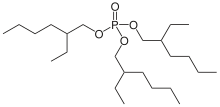Chemistry:Tris(2-ethylhexyl) phosphate
From HandWiki

| |
| Identifiers | |
|---|---|
3D model (JSmol)
|
|
| Abbreviations | TEHP |
| ChEBI | |
| ChEMBL | |
| ChemSpider | |
| EC Number |
|
PubChem CID
|
|
| RTECS number |
|
| UNII | |
| |
| |
| Properties | |
| C24H51O4P | |
| Molar mass | 434.642 g·mol−1 |
| Hazards | |
| GHS pictograms | 
|
| GHS Signal word | Warning |
| H315, H319, H335 | |
| P261, P264, P264+265Script error: No such module "Preview warning".Category:GHS errors, P271, P280, P302+352, P304+340, P305+351+338, P319Script error: No such module "Preview warning".Category:GHS errors, P321, P332+317Script error: No such module "Preview warning".Category:GHS errors, P337+317Script error: No such module "Preview warning".Category:GHS errors, P362+364Script error: No such module "Preview warning".Category:GHS errors, P403+233, P405, P501 | |
Except where otherwise noted, data are given for materials in their standard state (at 25 °C [77 °F], 100 kPa). | |
| Infobox references | |
Tris(2-ethylhexyl)phosphate (TEHP[2]) is an organic chemical compound in the organophosphate group. It is a triakylphosphate.
Occurrence
Since tris(2-ethylhexyl) phosphate is easily separated from polymers, it is often found in house dust[3]
Properties
Tris(2-ethylhexyl) phosphate is a colourless, viscous liquid with a faint, piercing smell. It has a viscosity of 15 mPas at 20 °C.[4]
Uses
Due to its properties (including that it is a mild biocide), tris(2-ethylhexyl)phosphate is used in a variety of applications:
- as a plasticizer in polymers (PVC, PU, NBR and others) giving good cold flexibility and flame retarding properties
- as a carrier for pigments and dyes used in colouring polymers
- as a component in cutting fluid[5]
- as a component in release agents, used in the metal casting industry
- as a solvent in hydrogen peroxide synthesis
Safety
When heated above its flash point of 170 °C, TEHP can release vapours capable of forming explosive mixtures with air.[6]
Several studies concluded that TEHP has the highest bioaccumulation factor of all organophosphate flame retardants examined.[7]
References
- ↑ "Tris(2-ethylhexyl) phosphate" (in en). https://pubchem.ncbi.nlm.nih.gov/compound/6537#section=Safety-and-Hazards.
- ↑ Bergman, Åke; Rydén, Andreas; Law, Robin J.; de Boer, Jacob; Covaci, Adrian; Alaee, Mehran; Birnbaum, Linda; Petreas, Myrto et al. (November 2012). "A novel abbreviation standard for organobromine, organochlorine and organophosphorus flame retardants and some characteristics of the chemicals" (in en). Environment International 49: 57–82. doi:10.1016/j.envint.2012.08.003. PMID 22982223.
- ↑ Wang, Lei; Jia, Yingting; Hu, Jianying (2022-07-01). "Nine alkyl organophosphate triesters newly identified in house dust" (in en). Environment International 165: 107333. doi:10.1016/j.envint.2022.107333. ISSN 0160-4120. https://www.sciencedirect.com/science/article/pii/S0160412022002604.
- ↑ PubChem. "Tris(2-ethylhexyl) phosphate" (in en). https://pubchem.ncbi.nlm.nih.gov/compound/6537.
- ↑ "TRIS(2-ETHYLHEXYL)PHOSPHATE (TEHP) |". https://atamankimya.com/sayfalar.asp?LanguageID=2&cid=3&id=978&id2=10459.
- ↑ "TRIS(2-ETHYLHEXYL)PHOSPHATE | CAMEO Chemicals | NOAA". https://cameochemicals.noaa.gov/chemical/20381.
- ↑ Bekele, Tadiyose Girma; Zhao, Hongxia; Wang, Qingzhi; Chen, Jingwen (2019-11-19). "Bioaccumulation and Trophic Transfer of Emerging Organophosphate Flame Retardants in the Marine Food Webs of Laizhou Bay, North China" (in en). Environmental Science & Technology 53 (22): 13417–13426. doi:10.1021/acs.est.9b03687. ISSN 0013-936X. PMID 31693343. Bibcode: 2019EnST...5313417B. https://pubs.acs.org/doi/10.1021/acs.est.9b03687.
 |

